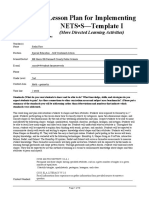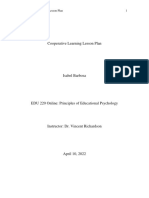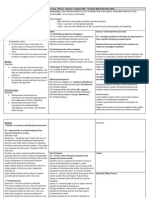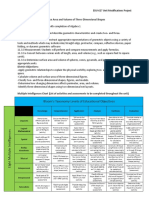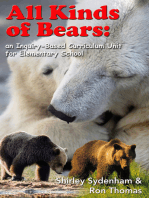Melissaburch-Lesson Plan - Shapes
Melissaburch-Lesson Plan - Shapes
Uploaded by
api-241903701Copyright:
Available Formats
Melissaburch-Lesson Plan - Shapes
Melissaburch-Lesson Plan - Shapes
Uploaded by
api-241903701Original Title
Copyright
Available Formats
Share this document
Did you find this document useful?
Is this content inappropriate?
Copyright:
Available Formats
Melissaburch-Lesson Plan - Shapes
Melissaburch-Lesson Plan - Shapes
Uploaded by
api-241903701Copyright:
Available Formats
Melissa Burch- Lesson 1 KPTP Lesson Plan Format Southwestern College Spring 2013 Topic Selected Math Geometry
y (Identifying 2D shapes- Real world connections) Curriculum Standard Addressed Domain: Geometry Cluster: Identify and describe shapes (circles, squares, triangles, rectangles, hexagons, cubes, cylinders, and spheres). Standard: K.G.1. Describe objects in the environment using names of shapes, and describe the relative position of these objects using terms such as above, below, beside, in front of, behind, and next to. ELA-Literacy.SL.K.1a. Follow agreed-upon rules for discussions (e.g., listening to others and taking turns speaking about the topics and texts under discussion). ELA-Literacy. SL.K.2. Confirm understanding of a text read aloud or information presented orally or through other media by asking and answering questions about key details and requesting clarification if something is not understood. Lesson Objectives The students will be able to identify 2D shapes based on their attributes. The students will be able to make connections between shapes and real world objects. The students will continue to develop listening skills. Students will display understanding by asking and answering questions. Connection to Student Background Knowledge Having a whole class discussion will give me an idea of the students prior knowledge of basic shapes. We will make connections with shapes and objects in the environment based on their prior knowledge. Assessment for lesson objectives Prior to teaching the unit a pre-assessment will be given that will have students identify and describe shapes, and make connections to real world objects. This assessment will be done through observation and discussion. Assessment through observation and discussion will be ongoing. A formative assessment will also be given in which students will have to draw a line to match shapes of different orientation. Model(s) of instruction used Whole class discussion- guided practice-teacher center-student centered Level of Understanding (e.g. Blooms Taxonomy) Blooms Taxonomy X Knowledge / Pre-assess prior knowledge X Comprehension / discuss material read by the teacher. Giving examples of real world objects.
X X X X
Application / Tracing and matching Analysis / Compare and contrast Synthesis / Creating with shapes Evaluation / Group discussion/Book/Shapes
Differentiated Instruction This lesson is appropriate for learners of various levels; however my lowest level learner will be given hand over hand assistance for tracing shapes if needed. Students who are reluctant to participate will be prompted in answering questions and encouraged to participate in activities. Reading Strategy Teacher will read aloud and students will think-pair-share when appropriate. Teacher will ask comprehension questions during the reading to ensure students understanding. Prompting will be provided for reluctant students. Technology Use Elmo Instruction Computer- video www.youtube.com Harrys Kindergarten Shapes
Community Resources Public Library-Discussions about shapes they can find on the playgrounds, in parks, on the streets, and around town. Materials Mouse Shapes by Ellen Stoll Walsh Match the Shapes worksheet Trace shapes sheet
Procedure: 1. Pre-assessment discussion regarding prior knowledge about shapes in the environment, and objects that they are familiar with. Students will identify shapes when they are held up. Observation and discussion will be done as a pre-assessment. Discuss shapes and their attributes. Read book Mouse Shapes by Ellen Stoll Walsh. Discuss the story as it is read to check for comprehension, and to encourage thinking skills. Students will be given dry erase markers and will trace shapes. Students will listen to and watch video on www.youtube.com
2. 3. 4. 5.
Melissa Burch Lesson 2 KPTP Lesson Plan Format Southwestern College Spring 2013 Topic Selected Math- Geometry (Identifying 2D shapes- Real world connections) Curriculum Standard Addressed Domain: Geometry Cluster: Identify and describe shapes (circles, squares, triangles, rectangles, hexagons, cubes, cylinders, and spheres). Standard: K.G.1. Describe objects in the environment using names of shapes, and describe the relative position of these objects using terms such as above, below, beside, in front of, behind, and next to. Standard: K.G.2. Correctly name shapes regardless of their orientation or overall size. ELA-Literacy.W.K.2. Use a combination of drawing, dictating, and writing to compose informative/explanatory texts in which they name what they are writing about and supply some information about the topic. ELA-Literacy.SL.K.1a. Follow agreed-upon rules for discussions (e.g., listening to others and taking turns speaking about the topics and texts under discussion). ELA-Literacy. SL.K.2. Confirm understanding of a text read aloud or information presented orally or through other media by asking and answering questions about key details and requesting clarification if something is not understood. Lesson Objectives The students will be able to identify 2D shapes based on their attributes. The students will be able to identify shapes regardless of their size or orientation. The students will use verbal clues to draw and color shapes in their math journals. Students will display understanding by asking and answering questions. Connection to Student Background Knowledge Now that students have been exposed to shapes in the previous lesson, we will continue our discussion on shapes that we see in our environment. Students will use shapes to create pictures. Assessment for lesson objectives The assessment will be done through observation as they work at various labs, class discussion, and their ability to correctly name the shapes on the worksheet that will be completed prior to the lesson on the following day.
Model(s) of instruction used Teacher centered Student centered Guided practice Level of Understanding (e.g. Blooms Taxonomy) Knowledge / Pre-assess prior knowledge Comprehension / Group discussion. Giving examples of real world objects. Application / Labs Analysis / Compare and contrast Synthesis / Creating with shapes Evaluation / Group discussion/journal writing Differentiated Instruction This lesson is appropriate for learners of various levels; however my lowest level learner will be given more one on one direction in completing their math journal. Students will be working in groups while in labs. This will maximize learning for all students. Above level students will be encouraged to draw additional shapes and their number of sides in their math journal. Students who are reluctant to participate will be prompted in answering questions and encouraged to participate in activities. Reading Strategy Reading Strategies: Teacher will ask comprehension questions to ensure students understanding. Prompting will be provided for reluctant students. Creating a T-chart of shapes covered. While writing in their math journals the students will use strategies such as drawing pictures, making lines, and using resources around the room for words they cannot spell. Technology Use Elmo-Instruction Community Resources www.teachingchannel.org Public Library Materials Materials: Paper for T-chart. Match the Shapes worksheet Trace the shape lab Zap (shape game) Foam shapes (used to make creative pictures from shapes) Math journals
Procedures: 1. Pre-assessment discussion regarding prior knowledge about shapes in the environment, and objects that they are familiar with. Teacher will hold up shapes and call on students to name them, and their number of sides. Students will do a shape matching worksheet that will serve as a formative assessment for the prior days instruction. (During MTSS time) Teacher and students will create a T-chart with learned shapes and attributes. Students will participate in labs that will allow them to practice what they are learning about shapes and their attributes. Trace the shape lab Zap (shape game) Foam shapes (used to make creative pictures from shapes) Pattern blocks and picture templates Students will draw shapes in their math journals and write the name for each.
2. 3. 4. a. b. c. d. 5.
You might also like
- @TradersLibrary2 The 30 Minute Stock Trader by Laurens Bensdorp PDFDocument161 pages@TradersLibrary2 The 30 Minute Stock Trader by Laurens Bensdorp PDFAbha Patel100% (10)
- Graffiti Model Lesson PlanDocument9 pagesGraffiti Model Lesson Planapi-286619177100% (1)
- Math 5e Lesson Planning Template Spring 2021Document9 pagesMath 5e Lesson Planning Template Spring 2021api-457377507No ratings yet
- Lesson Plan For 2nd Grade GeometryDocument21 pagesLesson Plan For 2nd Grade GeometryStephen Seitz67% (3)
- Math Inquiry LessonDocument4 pagesMath Inquiry Lessonapi-409093587No ratings yet
- TVDocument18 pagesTVPriyanshNo ratings yet
- Jaroslav Sasel - Trajan's Canal at The Iron GateDocument8 pagesJaroslav Sasel - Trajan's Canal at The Iron GateLuciusQuietusNo ratings yet
- LivetextLPTemplate Symmetry ELE311Document4 pagesLivetextLPTemplate Symmetry ELE311nancysamy22No ratings yet
- Lesson Plan - Lbs 340 1Document4 pagesLesson Plan - Lbs 340 1api-310933742No ratings yet
- (Complete Answers in Purple Font) : STEM 433/533 Lesson Planning TemplateDocument4 pages(Complete Answers in Purple Font) : STEM 433/533 Lesson Planning Templateapi-510369386No ratings yet
- Required Lesson Plan FormatDocument8 pagesRequired Lesson Plan FormatMr. BranNo ratings yet
- Collaborative Unit PlanDocument4 pagesCollaborative Unit Planapi-239620138No ratings yet
- Shapes Lesson SequenceDocument2 pagesShapes Lesson Sequenceapi-282152955No ratings yet
- Required Lesson Plan FormatDocument8 pagesRequired Lesson Plan FormatIzzy Joseph ZetinaNo ratings yet
- Unit 3 LetterDocument5 pagesUnit 3 Letterapi-237760840No ratings yet
- Im Filthy Im Dirty Lesson PlanDocument2 pagesIm Filthy Im Dirty Lesson Planapi-217077367No ratings yet
- Nicole Dostaler - First Grade - Geometry UnitDocument84 pagesNicole Dostaler - First Grade - Geometry UnitNicole Dostaler75% (4)
- 109 Architecture-Shape FINAL With PictureDocument5 pages109 Architecture-Shape FINAL With PictureAreniego Charmaine SuyatNo ratings yet
- Module 2 Lesson Plan: Content AreaDocument4 pagesModule 2 Lesson Plan: Content Areaapi-309170643No ratings yet
- Lesson Planning Form For Accessible Instruction - Calvin College Education ProgramDocument4 pagesLesson Planning Form For Accessible Instruction - Calvin College Education Programapi-300871680No ratings yet
- Mathematical Session 1Document4 pagesMathematical Session 1ScribdTranslationsNo ratings yet
- Edu 570 m3 Applicationassignment-Wk6 KolbDocument2 pagesEdu 570 m3 Applicationassignment-Wk6 Kolbapi-314705088No ratings yet
- Learning Experience Outline Mathematics Model Lesson: 1. Name: Lyndsey Wells 2. Grade Level and TitleDocument5 pagesLearning Experience Outline Mathematics Model Lesson: 1. Name: Lyndsey Wells 2. Grade Level and Titleapi-291718380No ratings yet
- Congruence and Similarity Lesson PlanDocument3 pagesCongruence and Similarity Lesson Planbshashi9100% (1)
- StemDocument7 pagesStemapi-271496734No ratings yet
- Mini Lesson Plan 6Document3 pagesMini Lesson Plan 6api-260889954No ratings yet
- RUNNING HEAD: Integrated Classroom ProjectDocument25 pagesRUNNING HEAD: Integrated Classroom Projectapi-247029058No ratings yet
- Math 5e Lesson PlanDocument4 pagesMath 5e Lesson Planapi-644431489No ratings yet
- Ê Ê Êtessellation Insights Ê Ê 8 Ê Mathematics Ê Êcaitlin Lynchêê Êgeometry/Anglesê ÊDocument6 pagesÊ Ê Êtessellation Insights Ê Ê 8 Ê Mathematics Ê Êcaitlin Lynchêê Êgeometry/Anglesê Êcaitlynch928No ratings yet
- Tangram LessonDocument17 pagesTangram Lessondbrizzolara191No ratings yet
- ITEC 7430 Lesson PlanDocument10 pagesITEC 7430 Lesson Plansydni ross100% (1)
- Cooperative Learning Lesson Plan Edu 220 4-10-2022Document7 pagesCooperative Learning Lesson Plan Edu 220 4-10-2022api-570743058No ratings yet
- 3D ShapesDocument4 pages3D ShapesBee House MaterialsNo ratings yet
- 03 05 2024 Lesson 13-6Document10 pages03 05 2024 Lesson 13-6api-718346915No ratings yet
- "Caring, Competent, Qualified Professionals" Knowledge of Content, Knowledge of Pedagogy, Professional SkillsDocument4 pages"Caring, Competent, Qualified Professionals" Knowledge of Content, Knowledge of Pedagogy, Professional SkillsAnnmarie McGonagleNo ratings yet
- Co-Teach Lesson Plan For PortfolioDocument5 pagesCo-Teach Lesson Plan For Portfolioapi-599233683No ratings yet
- Lines of InquiryDocument3 pagesLines of InquiryteacherensNo ratings yet
- Measurement Centres - Unit PlanDocument16 pagesMeasurement Centres - Unit Planapi-215073003No ratings yet
- Lesson Plan 205Document3 pagesLesson Plan 205api-301335627No ratings yet
- Finding Slope Lesson PlanDocument6 pagesFinding Slope Lesson Planapi-254064000No ratings yet
- TransformingparabolasDocument14 pagesTransformingparabolasapi-252581591No ratings yet
- Quadrilaterals Lesson PlanDocument3 pagesQuadrilaterals Lesson Planapi-194359519No ratings yet
- Et347 Storybird Matrix 2Document11 pagesEt347 Storybird Matrix 2api-302203378No ratings yet
- Voulme Lesson 1Document4 pagesVoulme Lesson 1api-330599039No ratings yet
- How Weather Has Change (Reading Comprehension)Document2 pagesHow Weather Has Change (Reading Comprehension)Anel RiveraNo ratings yet
- Saylor lp3Document3 pagesSaylor lp3api-225971153No ratings yet
- Mystery Shape Bag - Unit 5 Lesson GMDocument5 pagesMystery Shape Bag - Unit 5 Lesson GMapi-273593178No ratings yet
- Mi Unit ModificationsDocument16 pagesMi Unit Modificationsapi-324891328No ratings yet
- Mesheau Curriculum 2020-21Document9 pagesMesheau Curriculum 2020-21api-295743414No ratings yet
- Artist LP TenureDocument5 pagesArtist LP Tenureapi-526420053No ratings yet
- Science Unit Lesson ThreeDocument3 pagesScience Unit Lesson Threeapi-252387195No ratings yet
- Science Unit Lesson 4Document3 pagesScience Unit Lesson 4api-252387195No ratings yet
- Observation 1 LessonDocument7 pagesObservation 1 Lessonapi-400989959No ratings yet
- Saylor lp1Document3 pagesSaylor lp1api-225971153No ratings yet
- 320 Psych LP - OrganizersDocument8 pages320 Psych LP - Organizersapi-310123009No ratings yet
- Stage 2 Learning Sequence in MathematicsDocument3 pagesStage 2 Learning Sequence in Mathematicsapi-292905348No ratings yet
- Scatter Plot Lesson PlanDocument8 pagesScatter Plot Lesson Planapi-254064000No ratings yet
- Social Justice Lesson PlanDocument9 pagesSocial Justice Lesson Planapi-350131256No ratings yet
- 5 History Lesson DeruiterDocument4 pages5 History Lesson Deruiterapi-337281159No ratings yet
- Lesson Plan EdtpaDocument15 pagesLesson Plan Edtpaapi-238284715No ratings yet
- Edma Assignment 1 Lesson PlanDocument5 pagesEdma Assignment 1 Lesson Planapi-659203109No ratings yet
- Informational Text Toolkit: Research-based Strategies for the Common Core StandardsFrom EverandInformational Text Toolkit: Research-based Strategies for the Common Core StandardsNo ratings yet
- Snowflake Fundamentals Anand JhaDocument50 pagesSnowflake Fundamentals Anand Jhasomu kNo ratings yet
- Question Bank 3 and 4 UnitDocument8 pagesQuestion Bank 3 and 4 Unitanlacetech133No ratings yet
- CHE3044F, 2013: Reactor Design 1: TUTORIAL 2Document2 pagesCHE3044F, 2013: Reactor Design 1: TUTORIAL 2nmhatityeNo ratings yet
- Achi in EnglishDocument7 pagesAchi in Englishjadranka333No ratings yet
- Kegel Exercises 4 Pelvic Floor MusclesDocument10 pagesKegel Exercises 4 Pelvic Floor MusclesSHAIK SHABEENA100% (1)
- F2 Science Sensing The EnvironmentDocument30 pagesF2 Science Sensing The EnvironmentYuenHei Kwok100% (1)
- ADHD Coaching-A Practical GuideDocument5 pagesADHD Coaching-A Practical GuideMariano Navarro-Rubio TroisfontainesNo ratings yet
- Special Purpose Coupons Holder AssembliesDocument3 pagesSpecial Purpose Coupons Holder AssembliesLekhamani YadavNo ratings yet
- How To Hack Into Facebook Without BeingDocument4 pagesHow To Hack Into Facebook Without Beingkohtetgyi147369No ratings yet
- Chapter 8 - NotesDocument20 pagesChapter 8 - NotesPraneethNo ratings yet
- 1 AC 200 282C ILT 001 Syllabus Introduction AppendicesDocument36 pages1 AC 200 282C ILT 001 Syllabus Introduction AppendicesaaaguilarmNo ratings yet
- Red Hat Enterprise Linux 9 Securing Networks en UsDocument94 pagesRed Hat Enterprise Linux 9 Securing Networks en Usbent vaderNo ratings yet
- Siebel Order Management Guide Addendum For Industry ApplicationsDocument130 pagesSiebel Order Management Guide Addendum For Industry ApplicationsjeevananthamgNo ratings yet
- Extra Ordinary Gazette Date: 15.11.2019 Last Date: 18.12.2019 CATEGORY NO: 192/2019Document5 pagesExtra Ordinary Gazette Date: 15.11.2019 Last Date: 18.12.2019 CATEGORY NO: 192/2019trismaheshNo ratings yet
- MKTG Analytics-Final ProjectDocument46 pagesMKTG Analytics-Final Projectapi-728810138No ratings yet
- Multiple IntelligencesDocument2 pagesMultiple IntelligencesNtsako BaloyiNo ratings yet
- Walt Whitman - Songs of Democracy (1919)Document200 pagesWalt Whitman - Songs of Democracy (1919)Waterwind100% (2)
- Patterns of Development DefinitionDocument24 pagesPatterns of Development DefinitionIrene Tagalog100% (1)
- Chemical Kinetics - NEET Previous Year Questions With Complete SolutionsDocument12 pagesChemical Kinetics - NEET Previous Year Questions With Complete SolutionsRahul RanjanNo ratings yet
- Chapter 6 Well Completion and StimulationDocument25 pagesChapter 6 Well Completion and StimulationDeniz AkoumNo ratings yet
- Methanol Information 2 PDFDocument5 pagesMethanol Information 2 PDFPark RangerNo ratings yet
- PT Corona Dwi DayaDocument8 pagesPT Corona Dwi Dayaandi rafiansyahNo ratings yet
- 34 Quadruple Boost Multilevel Inverter QB-MLI Topology With Reduced Switch CountDocument6 pages34 Quadruple Boost Multilevel Inverter QB-MLI Topology With Reduced Switch CountRanesh SubramaniNo ratings yet
- IJME-Impact of Single-Multi Rollers Burnishing Tools - IASETDocument14 pagesIJME-Impact of Single-Multi Rollers Burnishing Tools - IASETiaset123No ratings yet
- ORTIZ - AMAZING - (M2 Lesson 2 - Types of Sources - While-Task 2)Document2 pagesORTIZ - AMAZING - (M2 Lesson 2 - Types of Sources - While-Task 2)ace starNo ratings yet
- Physics: DPP - Daily Practice ProblemsDocument3 pagesPhysics: DPP - Daily Practice Problemslalithasaranya018No ratings yet
- Loughton Brook Geography CourseworkDocument4 pagesLoughton Brook Geography Courseworkafjweyxnmvoqeo100% (2)






























